| Launch:2019-07-26 |
* Introduction
Raman spectroscopy as a novel spectroscopic detection technology has been widely used in the analysis of physical and chemical structure of materials. This technique can be used to detect meat quickly and nondestructively. It is one of the techniques of meat composition analysis. Its spectrum is extremely insensitive to polar substances such as water.
During the process of meat processing and storage, the main components of meat, such as protein and fat, will change, along with the changes of its functional and tissue characteristics, which will affect the quality of its flavor, color, texture and water retention. At the same time, there will be illegal use of illegal molecules to promote growth in livestock and poultry feeding. Additive. Raman spectroscopy can qualitatively analyze the relationship between the molecular structure of these components and various groups in meat products, and then detect the quality of meat products. In addition, semi-quantitative analysis can be carried out according to the relationship between the intensity of Raman spectroscopy peak and the concentration of the substance under test.
* Application
Rapid detection of clenbuterol in fresh meat by surface enhanced Raman spectroscopy
In recent years, the problem of lean meat powder is frequent, lean meat powder is a kind of synthetic beta-2-adrenaline stimulant, salbutamol is one of them. It is urgent to establish a rapid and effective method for the determination of salbutamol. At present, the main methods for the determination of salbutamol are high performance liquid chromatography, liquid chromatography-mass spectrometry, gas chromatography-mass spectrometry, spectrophotometry, enzyme-linked immunosorbent assay and so on. Although the detection rate is high, the sample processing is too complicated and the detection time is too long. Raman spectroscopy has the advantages of high sensitivity and fast analysis speed. Surface-enhanced Raman spectroscopy has great potential in the detection of small molecules.
Salbutamol in muscle and liver samples was measured by a 785 nm, 450 mW Raman spectrometer. Fig. 1
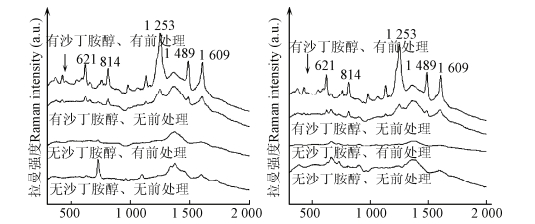
a. Muscle tissue b. Liver tissue
Fig.1 Surface Enhanced Raman spectrogram of muscle tissue and liver
Pretreatment is mainly carried out with the dissolution of salbutamol and ethyl acetate. The results showed that salbutamol could be detected clearly after sample treatment

Fig.2 Surface Enhanced Raman Spectroscopy and Correction Spectroscopy of Salbutamol Standard Solutions with Different Concentrations
Sabutamol of different mass concentrations were detected, and the results were shown in Fig. 2. Raman spectroscopy was used to semi-quantify the content of salbutamol.
Detection of banned and restricted drugs in fish by surface enhanced Raman spectroscopy
In the process of aquaculture and aquatic products storage and transportation, the abuse of industrial dyes and antibiotics has become a serious food safety problem. The abuse of fish drugs not only threatens the health of consumers and social unity and stability, but also produces export and trade of aquatic products and even other animal foods in China. Loss. Malachite green and crystal violet in fish extracts were detected by using 633 nm, 5 MW Raman laser with conventional Raman spectroscopy and surface-enhanced Raman spectroscopy, respectively. The results are as follows: Fig.3
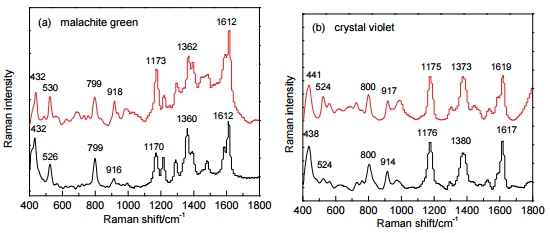
a. malachite green b .crystal violet
Fig.3 surface enhanced Raman spectrum (red) and ordinary Raman spectrum (black)
Chloramphenicol and sulfamethoxazole in fish extracts were detected by a 780 nm, 10 mW Raman spectrometer using conventional Raman spectroscopy and surface-enhanced Raman spectroscopy, respectively.
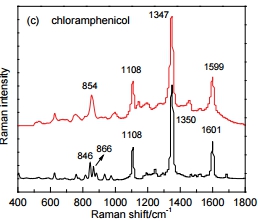
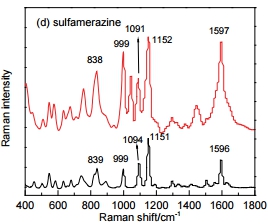
c .chloramphenicol d. Sulfamethazine
Fig.4 surface enhanced Raman spectrum (red) and ordinary Raman spectrum (black)
Malachite Green, Crystal Violet, Chloramphenicol and Sulfamethopyrimidine at different concentrations were detected, as shown in Fig.5
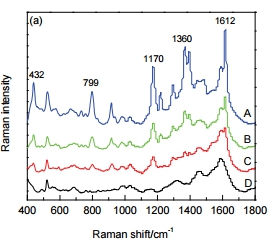
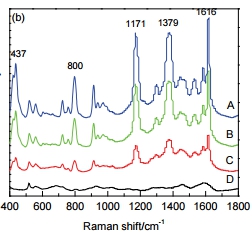
Fig.5 (a) Surface Enhanced Raman Spectra of Fish Meat Extracts Containing Different Concentrations of Malachite Green(A 10μg/Kg , B 5.0μg/L , C 1.0 μg/kg , D 0 μg/kg),
(b) Surface-enhanced Raman spectra of fish meat extracts with different concentrations of crystal violet (A 80 μg/kg , B 40 μg/kg , C 20 μg/kg , D 0 μg/kg)
Surface enhanced Raman spectroscopy (SERS) was used to detect the residues of industrial dyes (malachite green, crystal violet) and antibiotics (chloramphenicol and sulfamethopyrimidine) in aquatic products. The lowest detectability of four residues were malachite green, 0.8ug/L; crystal violet, 10ug/L; chloramphenicol, 50ug/L; sulfamethopyrimidine, 500ug/L; and the lowest detectable concentrations of malachite green and crystal violet were 1.0 and 20ug/kg respectively. It can be seen that Raman spectroscopy is suitable for the detection of residues in aquatic products.
In food safety monitoring, Raman spectroscopy has a simple operability, strong particularity and very high sensitivity. It has been widely used in practice and plays a very important role in food safety monitoring. With the maturity of Raman spectroscopy technology and the improvement of equipment, the detection of food safety will be more assured.
Reference:
Surface-enhanced Raman spectroscopy for rapid detection of clenbuterol in raw meat, Chen Zhai
Surface Enhanced Raman Spectroscopy for the Detection of Banned and Restricted Drugs in Fish Meat, Chunying Li

